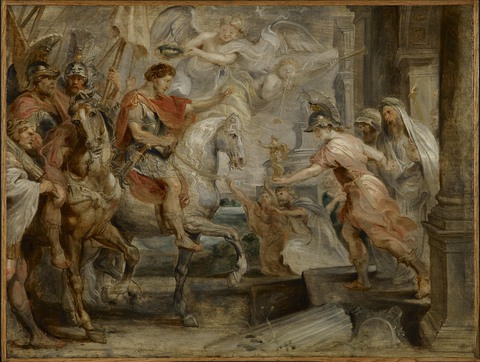Marks, Inscriptions, and Distinguishing Features
None
Entry
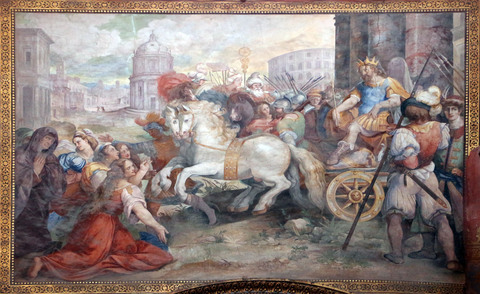
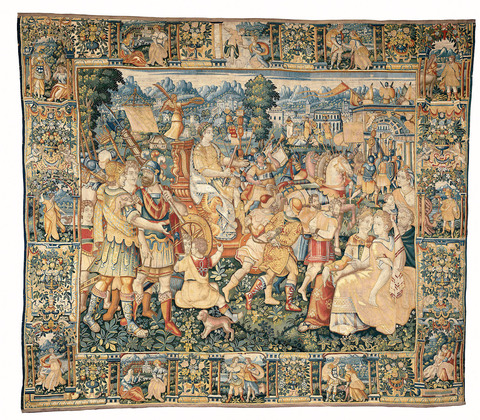
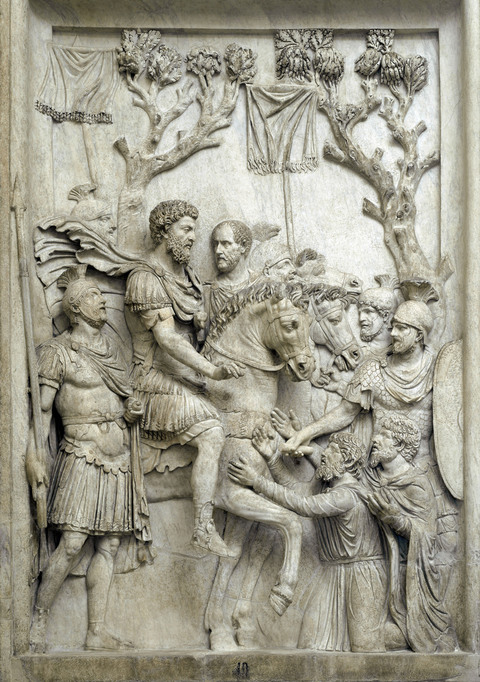
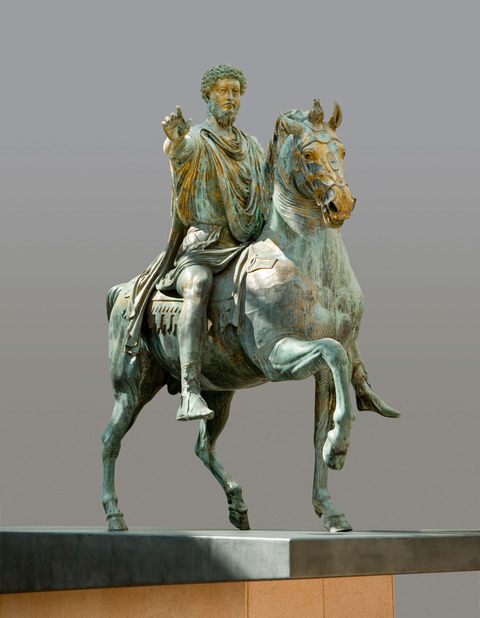
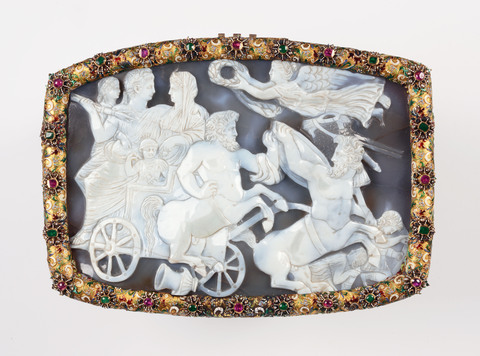
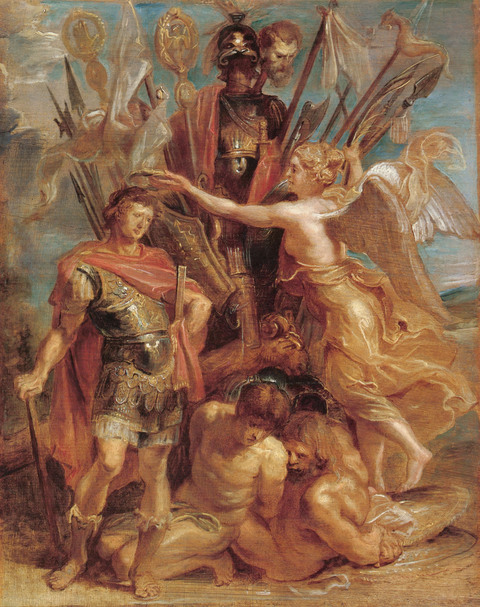
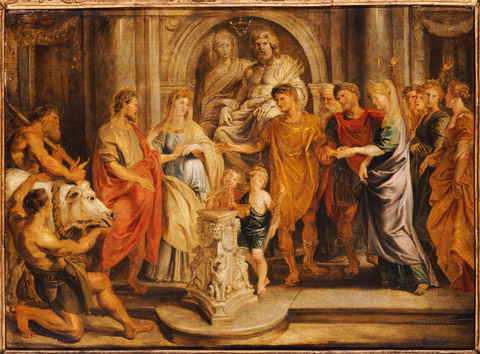
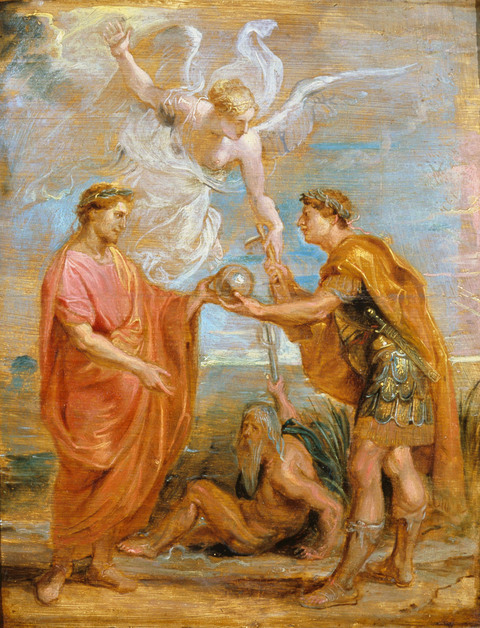
Author
Provenance
Marc Comans (1563–1644) and François de la Planche, known also by his Flemish name Frans van der Plancken, (1573–1627), owners of the Faubourg Saint-Marcel manufactory in Paris;36
Probably owned by the Comans family until about 1640–1660.37
Possibly in the collection of Henri de Valois (1603–1676) or his brother, Adrien de Valois (1607–1692), Paris, until 1676 or 1692.38
Philippe II d’Orléans (1674–1723) by 1723;39
By descent to Louis-Philippe-Joseph d’Orléans (1747–1793), Paris, until 1792;40
Thomas Moore Slade in association with George, 7th Lord Kinnaird (1754–1805), William Morland (1739–1815) and Thomas Hammersley (1747–1812).41
Robert Banks Jenkinson, Second Earl of Liverpool (1770–1828), by 1815;
Sale at (Christie’s, London) of Jenkinson’s estate in 1829;42
John Smith (active 1825–1849), London;43
George John, 5th Baron Vernon (1803–1866);44
Thomas Emmerson (died 1855);
Sale at (Phillips Son & Neal, London) in 1832;45
“Marshall”;46
(Thomas Griffith, Norwood) in 1881;47
Georges Bottolier-Lasquin (died 1932), Paris, by 1887;48
To his brother, Henri Lasquin (died 1919), Paris, by 1913.49
Possibly (Galerie Van Diemen & Company, New York) by 1931.50
(Newhouse Galleries, New York) by 1956;51
G.H.A. Clowes, Indianapolis, in 1956;
The Clowes Fund, Indianapolis, from 1958–2001, and on long-term loan to the Indianapolis Museum of Art since 1971 (C10069);
Given to the Indianapolis Museum of Art, now the Indianapolis Museum of Art at Newfields, in 2001 (2001.237).
Exhibitions
Slade’s Gallery, Chatham, Kent, 1792–1793;
No. 125 Pall Mall, London, 1793, The Órleans Gallery now Exhibiting at the Great Rooms, late the Royal Academy, no. 58 (as part of the series of twelve designs of Triumphal Entry of Constantine);
British Institution, London, 1815, Pictures by Rubens, Rembrandt, Vandyke, and Other Artists of the Flemish and Dutch Schools, no. 121;
École des Beaux-Arts, Paris, 1887, Exposition au profit des inondés du Midi, no. 139;
John Herron Art Museum, Indianapolis, IN, 1959, Paintings from the Collection of George Henry Alexander Clowes, no. 50;
The Art Gallery, University of Notre Dame, South Bend, IN, 1962, A Lenten Exhibition, no. 43;
Indiana University Art Museum, Bloomington, IN, 1963, Northern European Painting—The Clowes Fund Collection, no. 32;
Philadelphia Museum of Art, 1964, Constantine The Great: The Tapestries—The Designs, no. 4a;
Bruce Museum of Arts and Science, Greenwich, CT; University of California, Berkeley Art Museum and Pacific Film Archive; Cincinnati Art Museum, 2004–2005, Drawn by the Brush: Oil Sketches by Peter Paul Rubens, no. 11;
Guangdong Museum, Guangzhou, China; Hunan Museum, Changsha, China; Chengdu Museum; 2020–2021, Rembrandt to Monet: 500 Years of European Painting.
References
Louis-François Dubois de Saint-Gelais, Description des tableaux du Palais Royal, avec la vie des peintres à la tête de leurs ouvrages: Dédiée a monseigneur le duc d’Orleans, premier prince du sang (Paris: Chez d’Houry, 1727), 409, no. 6;
M. l’abbé de Fontenai and Jacques Couché, Galerie du Palais royal, gravée d’après les tableaux des differentes écoles qui la composent, 3 vols. (Paris: Chez J. Couché, J. Bouilliard, 1786–1808), II, pl. 14;
The Orléans Gallery, Now Exhibiting at the Great Rooms, late the Royal Academy, No. 125, Pall Mall. (London: Orléans Gallery, 1793);
W. Buchanan, Memoirs of Painting, with a Chronological History of the Importation of Pictures by the Great Masters into England since the French Revolution, 2 vols. (London: Printed for R. Ackermann, 1824), 169, no. 7;
John Smith, A Catalogue Raisonné of the Works of the Most Eminent Dutch, Flemish, and French Painters, vol. 2 (London: Smith and Son, 1830), 204–205, no. 739;
G. F. Waagen, Works of Art and Artists in England, 3 vols. (London: John Murray, 1838), I, 341, no. 14;
Victor Charles Van Grimbergen (pseudonym Johannes Smit), Historische levensbeschryving van P.P. Rubens, ridder, heer van Steen enz.: Benevens eene naeuwkeurige opgave zijner schilderyen, berustende in hoven, kerken, en verdere openbaere gebouwen van Europa, met aenwyzing welke van de zelve in het koper zyn gebracht (Antwerp: L. J. de Cort, 1840), 320, no. 6;
André Henri Constant van Hasselt, Histoire de P.-P. Rubens (Brussels: Imprimerie de la Société des Beaux-Arts, 1840), 284, no. 583;
Alfred Michiels, Catalogue des tableaux et dessins de Rubens, avec l’indication des endroits où ils se trouvent (Paris: A. Delahays, 1854), 21, no. 510;
G. F. Waagen, Treasures of Art in Great Britain: Being an Account of the Chief Collections of Paintings, Drawings, Sculptures, Illuminated Mss., …, 3 vols. (London: John Murray, 1854), II, 502, no. 14;
Charles Blanc, Le trésor de la curiosité: Tiré des catalogues de ventes de tableaux, dessins, estampes, livres, marbres, bronzes, ivoires, terres cuites, vitraux, médailles, armes, porcelaines, meubles, émaux, lacques et autres objets d’art / avec divers notes et notices historiques & biographiques, et précédé d’une lettre à l’auteur sur la curiosité et les curieux, vol. 2 (Paris: Chez Ve. J. Renard, 1858), 151;
Exposition de tableaux de maîtres anciens au profits des inondés du midi, exh. cat (Paris: Imprimerie de l’art, 1887), 43, no. 139;
George Redford, Art Sales: A History of Sales of Pictures and other Works of Art, 2 vols. (London: [Bradbury, Agnew & Co., Printers: “Whitefriars” Press], 1888), II, 323;
Max Rooses, L’oeuvre de P.P. Rubens: Histoire et description de ses tableaux et dessins, vol. 3 (Antwerp: Jos. Maes, 1890), 213, no. 723;
Victor Champier and G.-Roger Sandoz, Le Palais-Royal d’après des documents inédits (1629–1900), vol. 1 (Paris: Société de Propagation des livres d’art, 1900), 519;
Max Rooses, Rubens’ leven en werken (Amsterdam: Elsevier, 1903), 368;
Casimir Stryienski, La galerie du régent, Philippe, duc d’Orléans (Paris: Goupil, 1913), 188, no. 478;
Algernon Graves, A Century of Loan Exhibitions, 1813–1912, vol. 3 (London: Algernon Graves, 1914), 1159;
Leo Van Puyvelde, Les Esquisses de Rubens (Bâle: Les Éditions Holbein, 1940), 28, no. 6;
Leo Van Puyvelde, The Sketches of Rubens (London: Kegan Paul, Trench, Trubner & Co., 1947), 29, no. 6;
Leo Van Puyvelde, Les Esquisses de Rubens (Bâle: Les Éditions Holbein, 1948), 28, no. 6;
David G. Carter, Paintings from the Collection of George Henry Alexander Clowes: A Memorial Exhibition, exh. cat. (Indianapolis: John Herron Art Museum, 1959), no. 50 (reproduced);
F. W. Bilodeau, “The Clowes Fund Collection at Indianapolis, Indiana,” The Connoisseur 148, no. 595 (August 1961): 6, 9 fig. 16;
John Howett, A Lenten Exhibition Loaned by the Clowes Fund, Incorporated of Indianapolis, exh. cat. (Notre Dame: University of Notre Dame, 1962), no. 43 (reproduced);
Henry R. Hope, Northern European Painting: The Clowes Fund Collection, exh. cat. (Bloomington, IN: Indiana University Art Museum, 1963), no. 32 (reproduced);
David DuBon, Catalogue of the Exhibition Constantine the Great: The Tapestries, The Designs, exh. cat. (Philadelphia: Philadelphia Museum of Art, 1964), 39–41, no. 4a, fig. 19;
David DuBon, Tapestries from the Samuel H. Kress Collection at the Philadelphia Museum of Art: The History of Constantine the Great Designed by Peter Paul Rubens and Pietro da Cortona (London: Phaidon, 1964), 10, 112, pl. 60;
Mark Roskill, “Clowes Collection Catalogue” (unpublished typed manuscript, IMA Clowes Archive, Indianapolis Museum of Art, Indianapolis, IN, 1968);
A. Ian Fraser, A Catalogue of the Clowes Collection (Indianapolis: Indianapolis Museum of Art, 1973), pp. xliii, 124–125 (reproduced);
Didier Bodart, Rubens e l’incisione nelle collezioni del Gabinetto Nazionale delle Stampe, exh. cat. (Rome: De Luca, 1977), 204 (under no. 462);
Julius S. Held, The Oil Sketches of Peter Paul Rubens: A Critical Catalogue, 2 vols. (Princeton, NJ: Published for the National Gallery of Art by Princeton University Press, 1980), I, 75–76, no, 43; II, p. 44 and pl. 9;
Anthony F. Janson and A. Ian Fraser, 100 Masterpieces of Painting: Indianapolis Museum of Art (Indianapolis: Indianapolis Museum of Art, 1980), 84–86 (reproduced);
Anthony F. Janson and A. Ian Fraser, Handbook of European and American Paintings to 1945: Indianapolis Museum of Art (Indianapolis: Indianapolis Museum of Art, 1981), unpag, (reproduced);
Didier Bodart, Rubens, trans. Glauco Felici (Milan: Arnoldo Mondadori Editore, 1985), 182, no. 586 (reproduced);
Christopher White, Peter Paul Rubens: Man and Artist (New Haven and London: Yale University Press, 1987), 171–172 (reproduced);
Holliday T. Day, ed. Indianapolis Museum of Art: Collections Handbook (Indianapolis: Indianapolis Museum of Art, 1988), 22 (reproduced);
Michael Jaffé, Rubens: Catalogo complete, trans. Germano Mulazzani (Milan: Rizzoli, 1989), 267, no. 683 (reproduced);
Peter Krüger, Studien zu Rubens’ Konstantinszyklus (Frankfurt am Main: Peter Lang, 1989), 175–179, 254, fig. VI/1.1;
Charles Scribner III, Peter Paul Rubens (New York: Harry N. Abrams, 1989), 29 fig. 46;
Guy C. Bauman and Walter A. Liedtke, Flemish Paintings in America: A Survey of Early Netherlandish and Flemish Paintings in the Public Collections of North America (Antwerp: Fonds Mercator, 1992), 360, no. 400 (reproduced);
Elizabeth McGrath, Rubens: Subjects from History, vol. 1, Text and Illustrations, Corpus Rubenianum Ludwig Burchard, part 13, ed. Arnout Balis (London: Harvey Miller, 1997), p. 87;
Isabelle Van Tichelen, “De Geschiedenis van Constantijn / The History of Constantine,” in Guy Delmarcel et al., Rubenstextiel / Rubens’s Textiles, exh. cat. (Antwerp: L. Denys, 1997), 59, 61, 74, fig. 17;
Christopher Brown and Hans Vlieghe, eds., Van Dyck: 1599–1641, exh. cat. (London: Royal Academy Publications, 1999), 278, fig. 1;
Nadeije Laneyrie-Dagen, Rubens (Paris: Hazan, 2003), 198 and fig. 103;
Alexis Merle du Bourg, Peter Paul Rubens et la France, 1600–1640 (Villeneuve d’Ascq: Presses Universitaires du Septentrion, 2004), 31 and 199, note 99;
Peter C. Sutton, Marjorie E. Wieseman and Nico van Hout, Drawn by the Brush: Oil Sketches by Peter Paul Rubens, exh. cat. (New Haven and London: Yale University Press, 2004), 29, 79, 126–129, no. 11 (reproduced);
Pascal-François Bertrand, Les tapisseries des Barberini et la décoration d’intérieur dans la Rome baroque, Studies in Western Tapestry, vol. 2 (Turnhout: Brepols, 2005), 179, note 155;
Ellen Wardwell Lee, ed. Indianapolis Museum of Art: Highlights of the Collection (Indianapolis: Indianapolis Museum of Art, 2005), 101 (reproduced);
Wolf Quednau, “Zum Wandel des Konstantin-Bildes in der Kunst: Raphael und Rubens/Pietro da Cortona,” in Alexander Demandt and Josef Engemann, eds., Konstantin der Grosse: Geschichte—Archäologie—Rezeption; Internationales Kolloquium vom 10.–15. Oktober 2005 an der Universität Trier zur Landesaustellung Rheinland-Pfalz 2007 “Konstantin der Grosse,” Schriftenreihe des Rheinischen Landesmuseums Trier, no. 32 (Trier: Konstantin-Austellungsgesellschaft, 2006), 279, note 52;
Koenraad Brosens, “Who Commissioned Rubens’s Constantine Series? A New Perspective: The Entrepreneurial Strategy of Marc Comans and François de la Planche,” Simiolus 33, no. 3 (2007/2008): 166, 172, fig. 5;
Koenraad Brosens, Rubens: Subjects from History, vol. 3, The Constantine Series, Corpus Rubenianum Ludwig Burchard, part 13, ed. Arnout Balis (London: Harvey Miller, 2011), 33, 45, 52, 58, 61, 110, 11, 112, 147, 150, 152, 162, 163, no. 7a (reproduced);
Paola Rapelli, Symbols of Power in Art, trans. Jay Hyams (Los Angeles: The J. Paul Getty Trust, 2011), 97 (reproduced);
Kjell M. Wangensteen, et al., Rembrandt to Monet: 500 Years of European Painting (Jiangsu Phoenix Literature and Art Publishing: Nanjing, 2020), 48–51 (reproduced);
Kjell M. Wangensteen, et al., Floating Lights and Shadows: 500 Years of European Painting (Jiangsu Phoenix Literature and Art Publishing: Nanjing, 2020), 48–51 (reproduced).
Notes
-
The diadem may reference the tradition upheld by Caesar Baronius that Constantine was the first emperor to wear a crown rather than a laurel wreath. See Julius S. Held, The Oil Sketches of Peter Paul Rubens: A Critical Catalogue, 2 vols. (Princeton, NJ: Published for the National Gallery of Art by Princeton University Press, 1980), 1:76. ↩︎
-
The other sketches are Constantius Appoints Constantine as His Successor (Sydney, Art Gallery of New South Wales, Gift of James Fairfax), The Vision of Constantine (Philadelphia Museum of Art, John G. Johnson Collection), The Labarum (private collection), The Battle against Maxentius (Kansas City, MO, The Nelson-Atkins Museum of Art, Purchase William Rockhill Nelson Trust), The Collapse of the Milvian Bridge (London, The Wallace Collection), The Trophy (private collection), The Marriages of Constantine and Licinius (private collection), The Baptism of Constantine (private collection), The Founding of Constantinople (Karlsruhe, Staatliche Kunsthalle), Constantine and Helena Worshiping the True Cross (private collection), The Death of Constantine (private collection), and Triumphant Rome (The Hague, Mauritshuis). Though thirteen sketches survive, only twelve tapestry panels were woven, as no tapestry was ever made after Triumphant Rome. For an overview of the scholarship on these “twelve-plus-one” sketches, see Koenraad Brosens, Rubens: Subjects from History, vol. 3, The Constantine Series, Corpus Rubenianum Ludwig Burchard, part 13, ed. Arnout Balis (London: Harvey Miller, 2011), 97–116. ↩︎
-
While the tapestry from the editio princeps follows the composition of the Clowes panel without major changes, the dimensions of the visual field have been altered such that the immediacy of action is heightened: the approximately square dimensions compress the interaction between Constantine and Rome. In addition, there is more greenery in the foreground of the woven panel, and the palette has been imbued with stronger contrast. ↩︎
-
For these prints, see Koenraad Brosens, Rubens: Subjects from History, vol. 3, The Constantine Series, Corpus Rubenianum Ludwig Burchard, part 13, ed. Arnout Balis (London: Harvey Miller, 2011), figs. 63 and 64. ↩︎
-
Koenraad Brosens, Rubens: Subjects from History, vol. 3, The Constantine Series, Corpus Rubenianum Ludwig Burchard, part 13, ed. Arnout Balis (London: Harvey Miller, 2011), 217. ↩︎
-
On the struggle for legitimacy as Caesar and, subsequently, Augustus during the early years of his reign, see Timothy D. Barnes, Constantine and Eusebius (Cambridge, MA: Harvard University Press, 1981), 27–34. ↩︎
-
On Constantine’s legendary conversion, see Timothy D. Barnes, Constantine and Eusebius (Cambridge, MA: Harvard University Press, 1981), 43. ↩︎
-
Timothy D. Barnes reports that Constantine also had a statue of himself holding the labarum erected in the Basilica of Maxentius as a signal that through this sign, he had liberated the city of Rome. See Timothy D. Barnes, Constantine and Eusebius (Cambridge, MA: Harvard University Press, 1981), 43–47. As such, the Clowes panel may be understood in the context of the liberation of Rome for Christianity as well as from the reign of Maxentius. ↩︎
-
“Duci sane omnibus videbantur subacta vitiorum agmina, quae urbem graviter obsederant; scelus domitum, victa perfidia, diffidens sibi audacia et importunitas catenata, furor vinctus; et cuncta crudelitas inani furore frendebat: superbia atque arrogantia debellatae, luxuries coercita, et libido constricta nexu ferreo tenebantur.” See Caesar Baronius, Annales Ecclesiastici denuo excusi et ad nostra usque tempora perducti, vol. 3, ed. Augustino Theiner (Paris: Barri-Ducis, 1864), 543. ↩︎
-
Koenraad Brosens, Rubens: Subjects from History, vol. 3, The Constantine Series, Corpus Rubenianum Ludwig Burchard, part 13, ed. Arnout Balis (London: Harvey Miller, 2011), 216. ↩︎
-
A third interpretation was present at the Villa Montalto but is now lost. See Koenraad Brosens, Rubens: Subjects from History, vol. 3, The Constantine Series, Corpus Rubenianum Ludwig Burchard, part 13, ed. Arnout Balis (London: Harvey Miller, 2011), 216. Other scenes of triumphant entry that Rubens knew include Andrea Mantegna’s Triumph of Julius Caesar (about 1484–92; Royal Collection Trust, Hampton Court), which Peter Krüger argues would have been seen by the artist first in Mantua and then in London in 1629; ancient coins showcasing the figure of Minerva holding a winged victory; and, more generally, scenes of the triumph of the Church and Christ’s entry into Jerusalem. See Peter Krüger, Studien zu Rubens’ Konstantinszyklus (Frankfurt am Main: Peter Lang, 1989), 176–179. ↩︎
-
The Arch was, in fact, erected by the Roman senate to commemorate Constantine’s defeat of Maxentius at the Milvian Bridge. ↩︎
-
David DuBon, Tapestries from the Samuel H. Kress Collection at the Philadelphia Museum of Art: The History of Constantine the Great Designed by Peter Paul Rubens and Pietro da Cortona (London: Phaidon, 1964), 10; and Julius S. Held, The Oil Sketches of Peter Paul Rubens: A Critical Catalogue, 2 vols. (Princeton, NJ: Published for the National Gallery of Art by Princeton University Press, 1980), I, 75–76. ↩︎
-
Koenraad Brosens, Rubens: Subjects from History, vol. 3, The Constantine Series, Corpus Rubenianum Ludwig Burchard, part 13, ed. Arnout Balis (London: Harvey Miller, 2011), 216. The Gemma Augustae features the personification of the Roman Empire crowning Augustus with oak leaves. ↩︎
-
Nancy de Grummond, “The Study of Classical Costume by Philip, Albert, and Peter Paul Rubens,” in Papers Presented at the International Rubens Symposium, April 14–16, 1982, The John and Mable Ringling Museum of Art (Sarasota, FL: The John and Mable Ringling Museum of Art, 1983), 78–79. ↩︎
-
Marjon van der Meulen, Rubens Copies after the Antique, vol. 1, Corpus Rubenianum Ludwig Burchard, part 23, ed. Arnout Balis (London: Harvey Miller, 1994), text ill. 73. For a larger perspective on Rubens’s representation of armor, see Emil Keiser, “Antikes im Werke des Rubens,” Münchner Jahrbuch der bildenden Kunst N.F. X, nos. 1/2 (1933): 127; Howard D. Rodee, “Rubens' Treatment of Antique Armor,” The Art Bulletin XLIX, no. 3 (September 1967): 223–230; and Nancy De Grummond, “The Study of Classical Costume by Philip, Albert, and Peter Paul Rubens,” in Papers Presented at the International Rubens Symposium, April 14–16, 1982, The John and Mable Ringling Museum of Art (Sarasota, FL: The John and Mable Ringling Museum of Art, 1983), pp. 78–93. ↩︎
-
The order in which the tapestries originally hung has been a subject of debate. See, for example, David DuBon, Tapestries from the Samuel H. Kress Collection at the Philadelphia Museum of Art: The History of Constantine the Great Designed by Peter Paul Rubens and Pietro da Cortona (London: Phaidon, 1964), 37–38; John Coolidge, “Louis XIII and Rubens: The Story of the Constantine Tapestries,” Gazette des beaux-arts 67, no. 6 (1966): 271–290; Julius S. Held, The Oil Sketches of Peter Paul Rubens: A Critical Catalogue, 2 vols. (Princeton, NJ: Published for the National Gallery of Art by Princeton University Press, 1980), I, 70–84; and Koenraad Brosens, Rubens: Subjects from History, vol. 3, The Constantine Series, Corpus Rubenianum Ludwig Burchard, part 13, ed. Arnout Balis (London: Harvey Miller, 2011), 147–155. ↩︎
-
This opening scene also complements the closing scene of The Death of Constantine, as Brosens highlights. See Koenraad Brosens, Rubens: Subjects from History, vol. 3, The Constantine Series, Corpus Rubenianum Ludwig Burchard, part 13, ed. Arnout Balis (London: Harvey Miller, 2011), 150. ↩︎
-
For Baronius’s account of the vision, the labarum and the battle against Maxentius, see Caesar Baronius, Annales Ecclesiastici denuo excusi et ad nostra usque tempora perducti, vol. 3, ed. Augustino Theiner (Paris: Barri-Ducis, 1864), 537–543. ↩︎
-
One of the telling pieces of evidence is the presence of Maxentius’s head on a pike in The Trophy. Baronius reports that soldiers beheaded the corpse of Maxentius after the Battle of the Milvian Bridge and paraded it during Constantine’s entry into the city. See Caesar Baronius, Annales Ecclesiastici denuo excusi et ad nostra usque tempora perducti, vol. 3, ed. Augustino Theiner (Paris: Barri-Ducis, 1864), 546. ↩︎
-
Koenraad Brosens, Rubens: Subjects from History, vol. 3, The Constantine Series, Corpus Rubenianum Ludwig Burchard, part 13, ed. Arnout Balis (London: Harvey Miller, 2011), 150–151. ↩︎
-
Brosens notes, for example, that only three of the eight known editions of the series feature all twelve woven panels. Koenraad Brosens, Rubens: Subjects from History, vol. 3, The Constantine Series, Corpus Rubenianum Ludwig Burchard, part 13, ed. Arnout Balis (London: Harvey Miller, 2011), 153–154. Krüger, in contrast, argues that the variety of dimensions of the panels suggests that the series was designed for a fixed space. See Peter Krüger, Studien zu Rubens’ Konstantinszyklus (Frankfurt am Main: Peter Lang, 1989), 21. ↩︎
-
Louis XIII gave seven of these twelve tapestries to Cardinal Francesco Barberini (1597–1679) in Paris on September 23, 1625, according to a letter penned by his assistant, Cassiano dal Pozzo (1588–1657): “Tornato alle stanze trovamo Monsu di Bonoil (mastro di ceremonie di Luigi XIII, addetto alla persona del legato) che era quivi, cò il segretario di Monsu di Leancourt ad aspettarlo per presentarli da parte del Re e di quell’altre Maestà otto pezzi di arazzo tessuti con oro e seta con istorie attinenti alla vita di Costantino di disegno del Rubens, de’quali nhavevano già attaccato uno nella camera cioè quello nel quale era espresso il Battesimo dell’Imperatore.” As transcribed in Koenraad Brosens, Rubens: Subjects from History, vol. 3, The Constantine Series, Corpus Rubenianum Ludwig Burchard, part 13, ed. Arnout Balis (London: Harvey Miller, 2011), 364. The eighth panel seems to have been left in Paris, according to a document of 1630 listing the tapestries in the Barberini collection and the 1627 inventory of François de la Planche. See Brosens, The Constantine Series, 366–367. In 1636–1637, the cardinal commissioned Pietro da Cortona (1596–1669) to design an additional five scenes plus a baldachin and dossal to be woven at the newly established Barberini tapestry manufactory in Rome. The entire collection of tapestries stayed in the Barberini collection until 1889, at which point the panels were split up, only to be reunited by Mitchell Samuels in December 1956. Samuels, in turn, sold the series in 1959 to the Samuel H. Kress Foundation, which then donated it to the Philadelphia Museum of Art. ↩︎
-
“Subito che il Sgr. de la Planche hebbe ricevuto la lettera ch’io gli mandai di parte di V.S. egli mi mando a dire ch’egli m’haverebbe fatto sborzare subito la somma di 500 lb. che V.S. gli scriveva disborzare, et havendo io inteso che certa tappezzaria ch’io gli haveva ordinata era quasi finita volsi sapere a cui termine a poco apprezzo la potrei sperare. Mi fu risposto che fra 15 à 20 giorni sarebbe fornita, il che mi mosse a non volere altramente darmi la brigga di numerare la somma poi che in si breve spatio di tempo io haveva da restituirla per il prezzo della tappezzaria, di maniera che non tenne a lui, ch’io non ricevessi subito i dannari contanti, ma a la mia negligenza di non volergli lasciare passare per le mie mani diverse volte in si breve spatio di tempo, si come io le scrissi allora, che V.S. ha havuto torto di havere improvato le nostre conventionti, che erano in termini di ogni raggione. Onde la preggo di non imputarne la causa ad altro et di commandarmi con ogni authorità, pregando le dal Sigr. ogni maggior bene.” As transcribed in Koenraad Brosens, Rubens: Subjects from History, vol. 3, The Constantine Series, Corpus Rubenianum Ludwig Burchard, part 13, ed. Arnout Balis (London: Harvey Miller, 2011), 359–360. A letter of August 4 also mentions a debt, but the letter dated a few weeks later better articulates the circumstances. ↩︎
-
Brosens observes that Rubens did not contact the French court about the payment but about the manufactory. See Koenraad Brosens, Rubens: Subjects from History, vol. 3, The Constantine Series, Corpus Rubenianum Ludwig Burchard, part 13, ed. Arnout Balis (London: Harvey Miller, 2011), 95. ↩︎
-
Julius S. Held, The Oil Sketches of Peter Paul Rubens: A Critical Catalogue, 2 vols. (Princeton, NJ: Published for the National Gallery of Art by Princeton University Press, 1980), 2:67. ↩︎
-
“Di modo ch’io non volsi mancar di trovarmi all’assignatione, il che non fu inutile poi che V.S. m’haveva scritto il particolare delli soggietti, che se ben gli altri sapevano in generale che erano della Vita di Constantino, nulladimeno non sapevano il particolar di chiascheduna historia ch’io gli andai esponendo….” As transcribed in Koenraad Brosens, Rubens: Subjects from History, vol. 3, The Constantine Series, Corpus Rubenianum Ludwig Burchard, part 13, ed. Arnout Balis (London: Harvey Miller, 2011), 361. ↩︎
-
A letter of 26 February 1626 from Rubens to Palamedes Fabri de Valavez (1582–1645), Peiresc’s brother, employs the phrase “in the service of Your Majesty,” but Brosens interprets this as but a gracious and elegant turn of phrase. See Koenraad Brosens, Rubens: Subjects from History, vol. 3, The Constantine Series, Corpus Rubenianum Ludwig Burchard, part 13, ed. Arnout Balis (London: Harvey Miller, 2011), 365. ↩︎
-
“Et si come non si pote far l’assemblea tanto secreta che non vi si incontrassero molte persone o venute a caso con l’arcivescovo nuovo di Pariggi, o con altri SSri. ch’andavano per comprar tappezzarie, o a posta per veder le sue opera….” As transcribed in Koenraad Brosens, Rubens: Subjects from History, vol. 3, The Constantine Series, Corpus Rubenianum Ludwig Burchard, part 13, ed. Arnout Balis (London: Harvey Miller, 2011), 361. ↩︎
-
Koenraad Brosens, Rubens: Subjects from History, vol. 3, The Constantine Series, Corpus Rubenianum Ludwig Burchard, part 13, ed. Arnout Balis (London: Harvey Miller, 2011), 127. ↩︎
-
Koenraad Brosens, Rubens: Subjects from History, vol. 3, The Constantine Series, Corpus Rubenianum Ludwig Burchard, part 13, ed. Arnout Balis (London: Harvey Miller, 2011), 80. ↩︎
-
Koenraad Brosens, Rubens: Subjects from History, vol. 3, The Constantine Series, Corpus Rubenianum Ludwig Burchard, part 13, ed. Arnout Balis (London: Harvey Miller, 2011), 81. ↩︎
-
Letter from Ludwig Burchard to G.H.A. Clowes, 1956, File 2001.237, Registration Historical Files, Indianapolis Museum of Art at Newfields. ↩︎
-
A few cracks in the lower half of the panel are the only marks of the passage of time on the surface. ↩︎
-
Though no bozzetti exist for the Constantine series, there are extant examples from Rubens’s next tapestry series, The Triumph of the Eucharist, which he began in the mid-1620s. See Anne T. Woollett, “Faith and Glory. The Infanta Isabel Clara Eugenia and the Triumph of the Eucharist,” Spectacular Rubens: The Triumph of the Eucharist, exh. cat., ed. Alejandro Vergara and Anne T. Woollett (Los Angeles: J. Paul Getty Trust, 2014), 22. ↩︎
-
It was presumably included in the 3 August to 1 September 1627 probate inventory of the Comans-De la Planche workshop taken upon the death of the latter in 1627: “Item douze petitz desseigns peintz en huille sur des planches de bois, de la main de Pierre Paul Rubens, représentant l’Histoire de Constantin, prisé à raison de 100# pièce 1,200#, " as transcribed in Koenraad Brosens, Rubens: Subjects from History, vol. 3, The Constantine Series, Corpus Rubenianum Ludwig Burchard, part 13, ed. Arnout Balis (London: Harvey Miller, 2011), 366, from the above cited inventory in the Archives Nationales, Paris. ↩︎
-
On the vagaries of the Comans-De la Planche workshop between 1627 and 1633, including its dissolution and the resulting division of shared property, see Koenraad Brosens, Rubens: Subjects from History, vol. 3, The Constantine Series, Corpus Rubenianum Ludwig Burchard, part 13, ed. Arnout Balis (London: Harvey Miller, 2011), 98–100. ↩︎
-
The Valois seal appears on the verso of The Milvian Bridge and The Death of Constantine, leading Brosens to speculate that more of the oil sketches may have been in this collection. See Koenraad Brosens, Rubens: Subjects from History, vol. 3, The Constantine Series, Corpus Rubenianum Ludwig Burchard, part 13, ed. Arnout Balis (London: Harvey Miller, 2011), 45, 102. Brosens nevertheless believes quite firmly that the twelve sketches were dispersed after 1627. See Koenraad Brosens, Rubens: Subjects from History, vol. 3, The Constantine Series, Corpus Rubenianum Ludwig Burchard, part 13, ed. Arnout Balis (London: Harvey Miller, 2011), 108. ↩︎
-
Twelve oil sketches are listed in the posthumous inventory of Phillipe II d’Orléans in 1724: “Item douze tableaux quarrés peints sur bois representant l’histoir de Constantin dans leurs bordures en bois sculptés doré numerotté 5. 6. 7. 8. 9. 10. 11. 12. 13. 14. 15. Prisés ensemble de la somme de deux mille quatre cent livres." See Koenraad Brosens, Rubens: Subjects from History, vol. 3, The Constantine Series, Corpus Rubenianum Ludwig Burchard, part 13, ed. Arnout Balis (London: Harvey Miller, 2011), 370. ↩︎
-
An inventory of the paintings in the collection of the duc d’Orléans was recorded in March 1792 by Jean-Baptiste-Pierre Lebrun for Thomas Moore Slade. It lists “Pierre Paul Rubens, 2 esquisses de l’histoire de Constantin 15,000,” and is transcribed in Koenraad Brosens, Rubens: Subjects from History, vol. 3, The Constantine Series, Corpus Rubenianum Ludwig Burchard, part 13, ed. Arnout Balis (London: Harvey Miller, 2011), 375. Brosens also mentions inventories of 1752 and 1785 of Louis d’Orléans (1703–1752) and Louis-Philippe d’Orléans (1725–1785) respectively. ↩︎
-
Brosens notes that this and other oil sketches from the Constantine series were offered for sale at Slade’s gallery in Chatham, Kent, in 1792–1793, and then again in London, at 125 Pall Mall in 1793. In the latter this oil sketch was no. 58. ↩︎
-
Christie’s London, Italian, French, Flemish and Dutch pictures, 25 May 1829, lot no. 63. ↩︎
-
Christie’s London, Italian, French, Flemish and Dutch pictures, 25 May 1829, lot no. 63, in an annotated copy at the Getty Research Institute. ↩︎
-
Provenance Index Database, Getty Research Institute, ledger of John Smith. ↩︎
-
Phillips Son & Neal, London, Splendid and Highly estimable collection of pictures, lot no. 70. ↩︎
-
Provenance Index Database, Getty Research Institute. ↩︎
-
George Redford, Art Sales: A History of Sales of Pictures and Other Works of Art (Whitefriars Press: London, 1888), 2:323. (Although this may refer to a copy of the oil sketch.) ↩︎
-
Georges Bottolier-Lasquin, or Georges B.-Lasquin, was a collector and “expert en art” for auction sales. He is listed as the owner of the oil sketch in the catalogue, Ecole des Beaux-Arts, Paris, Exposition [de tableaux de maîtres anciens] au profit des inondés du midi, 1887, 41, no 139. ↩︎
-
Henri Lasquin’s ownership is noted in Casimir Stryienski, La Galerie du regent, Philippe, duc d’Orléans, Paris, 1913, 188, no. 478. See also American Art News, “Death of ‘Expert’ Lasquin,” 1 February 1919, 5, for a brief biography of Lasquin. ↩︎
-
Katharine Grant Sterne, “Some Old Masters in New York Galleries,” Parnassus (February 1931), 10, mentions an oil sketch from the life of Constantine with “pink and yellow draperies swirling gaily against a grey sky.” For the painting’s location in the 1920s, the RKD, The Hague, suggests that it was included in a 1924 auction; this is in error, since the auction catalogue clearly indicates that no. 36 was a copy on canvas of the original, which is painted on oak panel. See Koninklijke Kunstzaal Kleykamp, The Hague, Vente collection importante tableaux et sculptures des XVe, XVIe, XVIIe siècles, appartenant à un amateur, 10 June 1924, 8 (introduction by C. Hofstede de Groot), lot no. 36 (reproduced). ↩︎
-
Bill of Sale, 6 February 1956, Newhouse correspondence, Clowes Registration Archive, Indianapolis Museum of Art at Newfields. ↩︎
